Carrie (1976) holds several special distinctions for me. It’s on the list of my top ten favorite horror movies. It’s my favorite film adaptation of a Stephen King novel. That novel (published in 1974) is my favorite Stephen King book, as well as the first I ever read. Finally, Carrie is my favorite film directed by Brian DePalma, who we’re here to talk about. While some of my high school peers were going to their junior prom, I was doing a prom-themed horror double feature of Carrie and Prom Night (1980). I was not a normal child. I did go to my senior prom though. For the record, I had a good time.
We’ll start with the book. Carrie was Stephen King’s first published novel. He almost quit writing it at one point. His wife, however, dug it out of the trash and encouraged him to finish it. Carrie White is the title character. She’s a teenage outcast. Her peers look down on her and ridicule her constantly. Carrie also has a religious fanatic of a mother, who may also be insane. Carrie discovers she has the power of telekinesis. This is the ability to move or to cause changes to objects by force of the mind. Carrie’s classmates play a cruel prank on her at the senior prom. So Carrie vengefully unleashes her powers at them.
Carrie is an epistolary novel. It does have some segments from its characters’ points-of-view. Though it also contains segments from books on either telekinesis or more specifically, the Carrie White affair. One such book is an autobiography by one of Carrie’s surviving classmates, Sue Snell. There are news articles, letters. There are transcriptions from a commission investigating what happened. 1979 is when the novel takes place. I suppose then you could consider it a futuristic novel. There’s also one amusing moment when Sue mentions a movie adaptation of the event. It’s as if Stephen King was predicting (or hoping) what was to come.
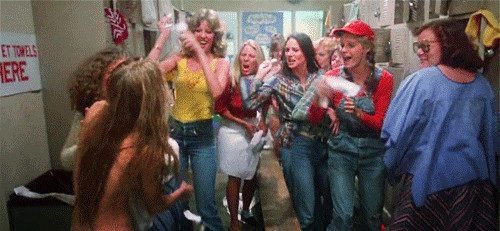
Brian DePalma’s 1976 film adaptation loses the epistolary style. There’s another big change between book and movie. In the book, Carrie White’s mayhem starts at the school, only to then spread through the whole town. I suppose the most faithful adaptation of the novel is the TV movie Carrie (2002). It’s decent for a TV movie, but I’d also say it’s the weakest of the adaptations. The theatrical remake Carrie (2013) fits somewhere in the middle. Chloe Grace Moretz (Kick-Ass, The Miseducation of Cameron Post) plays the title character in that adaptation. It’s hard to buy Moretz as an ugly duckling outcast.
There are a few other smaller changes. There’s a scene in the book featuring Carrie as a young girl. She has an interaction with a neighbor that ultimately leads to a rain of stones falling on the White house. Brian DePalma did film this scene but ultimately decided to cut it. I don’t believe Carrie ever works up the nerve to dance with Tommy Ross in the book. Gym teacher Miss Desjardin survives in the book and resigns as an educator. Miss Collins is the character’s name in the movie, and she sadly ends up being one of Carrie’s victims. There’s another difference involving her, but I’ll get to that later.
In the novel, people also appear to have a telepathic link with Carrie. There are people who don’t even know Carrie, but they’re able to recognize her based on this telepathy. Carrie slowly stops her mother’s heart in the book. In the movie, she forces perhaps a dozen kitchen implements to pierce her body. Carrie dies with her in the house in the movie. In the book, she dies in a field, with Sue Snell present to witness it. Sue isn’t present with Carrie as she dies in the movie, but she has nightmares afterward.
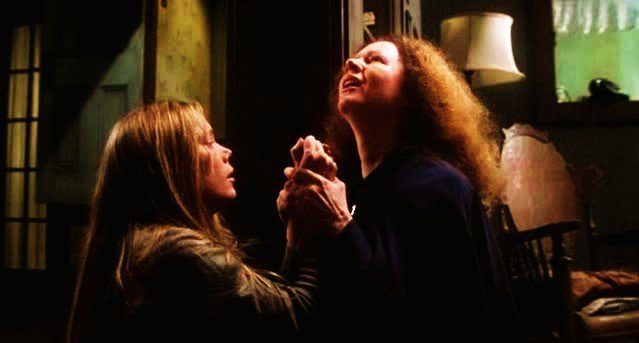
That’s enough comparisons between book and film. The 1976 film opens with a high school gym volleyball game. We see Carrie blow the hit that determines the game, and her female classmates give her hell for it. What everyone remembers though is the credit sequence. Women who we’re to believe are teenagers are in a locker room. Most of them are naked or partially naked though. It’s a bit off-putting. It’s also meant to be a sensual scene depicting vulnerability. That sensuality shifts to explosive chaos when Carrie discovers she’s having her first period. She’s a bit old for her first, and she also wasn’t even aware of menstruation. She thinks she’s dying, but her classmates find it hilarious. They throw sanitation napkins at her, chanting, “Plug it up!” repeatedly.
Their gym teacher Miss Collins puts a stop to it, but not before losing her cool towards Carrie herself. Some of these characters will feel remorse at their actions, such as Sue Snell. There are others who won’t, such as the bitchy Chris Hargensen. Chris doesn’t think a week’s detention led by Miss Collins is an example of the punishment fitting the crime. When she refuses to finish out the week, she’s denied access to the prom. Chris feels like she’s the true victim, and plots further humiliation towards Carrie.
Most of the film’s actors actually participated in a double audition. Brian DePalma was auditioning them for Carrie. George Lucas (American Graffiti) was auditioning them for Star Wars: Episode IV-A New Hope (1977). I like this cast, and there are some familiar faces. Amy Irving plays Sue Snell. She would appear in another Brian DePalma film, The Fury (1978). That wasn’t one of my favorite DePalma films. Though she’d also do an uncredited voice dubbing for his film Casualties of War (1988). People often overlook that DePalma film, but it’s among my favorites. Amy Irving is also the only actor who’d reprise their role in the average sequel The Rage: Carrie 2 (1999). At that point, Sue Snell has worked through her own demons and become a school psychologist. She tries to help another telekinetic teen named Rachel (Emily Bergl), who is also Carrie’s half-sister.

Priscilla Pointer (Blue Velvet, Twilight Zone: The Movie), who is Amy Irving’s actual mother, also plays Sue’s mother in the film. This wasn’t a character in the book. DePalma just thought it would be interesting. This isn’t the only film horror fans might recognize Priscilla Pointer from. She’s also in A Nightmare on Elm Street 3: Dream Warriors (1987) as Dr. Elizabeth Simms, the doctor we’re not supposed to like. William Katt plays Sue Snell’s boyfriend Tommy Ross. Katt would become popular on the TV series The Greatest American Hero. I however otherwise associate him with the fun horror-comedy House (1986), and the TV remake of Piranha (1995).
Nancy Allen (Poltergeist III, RoboCop) plays Chris Hargensen. She would end up marrying Brian DePalma, though they have since divorced. She would also appear in DePalma’s films Home Movies (1979), Dressed to Kill (1980), and Blow Out (1981). John Travolta (Pulp Fiction, Get Shorty) plays Chris’ boyfriend, Billy Nolan. Billy Nolan was a more intimidating character in the novel. In the movie, he’s more of a doofus…yet a strangely somewhat likable one. I think you can attribute this to the charisma Travolta brings to the role. It’s a somewhat smaller role. People mostly knew Travolta at the time from the TV series Welcome Back, Kotter. He would really break out after Carrie. First with his Oscar-nominated lead performance in Saturday Night Fever (1977), and then in Grease (1978). I love both of those musically-charged movies. Travolta would also reunite with Nancy Allen in DePalma’s Blow Out.
P.J. Soles (Stripes, The Devil’s Rejects) plays one of Chris’ friends and eventual co-conspirators, Norma Watson. She’s most distinctive as being the girl in the red baseball cap. P.J. Soles would actually rupture her eardrum during the prom massacre. She went on to totally star as Jamie Lee Curtis’ (The Fog, Prom Night) quirky blonde friend Lynda in the original Halloween (1978). That means a lot to me, as it’s my favorite horror film of all time. I’d say her most memorable role, however, is rock-‘n-roller Riff Randell in Rock ‘N’ Roll High School (1979). I love that movie too, which also made me a fan of the Ramones.
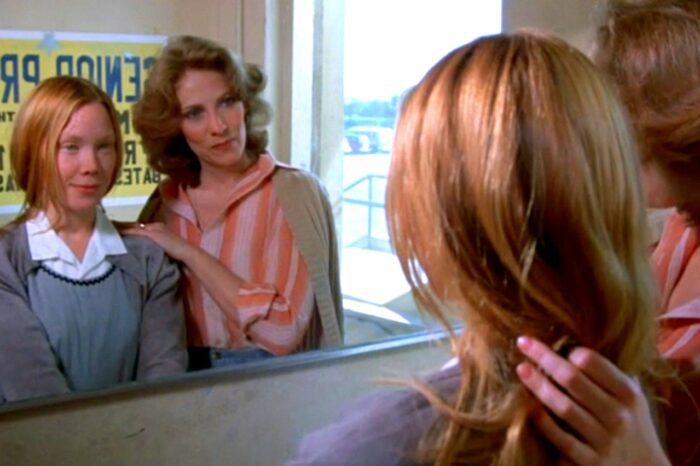
It’s also fun to spot Edie McClurg as one of the other girls named Helen. McClurg would go on to become most recognized as the secretary in the John Hughes classic, Ferris Bueller’s Day Off (1986). Betty Buckley wasn’t significantly older than these other actresses, even though she played their gym teacher, Miss Collins. Buckley is the only actor here to appear in the short-lived stage musical version of Carrie. She’d play Carrie’s mother Margaret White in that, however. I’ve liked seeing her pop up in a couple of M. Night Shyamalan films, The Happening (2008) and Split (2016).
One of the actors who didn’t audition for both movies would play Carrie White herself. Sissy Spacek (The Straight Story, Affliction) was a set dresser on Brian DePalma’s cult classic Phantom of the Paradise (1974). She was also the wife of production designer and art director Jack Fisk. He worked on both Phantom of the Paradise and Carrie as well. Yet DePalma told Spacek that she should probably take a commercial instead of auditioning for Carrie. He already had someone in mind for the role.
Spacek was intent on getting the part regardless. She went to the audition without showering or wearing makeup. She rubbed Vaseline in her hair and wore baggy clothing. It paid off. She not only got the role, but also an Oscar nomination for Best Actress. Sissy Spacek really is the driving force in getting us to feel sympathy for Carrie White. This sympathy was in the book too, but Spacek brings it to life. In fact, I think Carrie is perhaps the most sympathetic horror “killer” we’ve ever seen on screen. That’s because we understand she is just as much a victim as she is a killer, if not more so. The only horror killer perhaps equally sympathetic is Norman Bates in Psycho (1960). That was also thanks to an amazing, Oscar-worthy performance from Anthony Perkins (Catch-22, A Demon in My View).
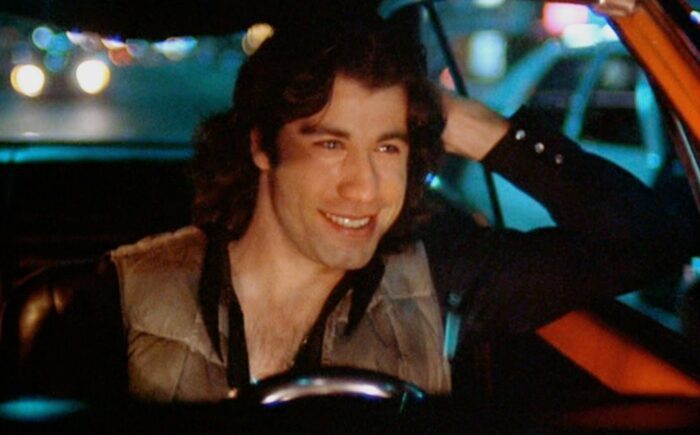
Piper Laurie (The Faculty) would also get an Oscar nomination for Carrie. This was for Best Supporting actress as Carrie’s crazy religious mother, Margaret White. Oscar attention is a rarity for horror films, but both actresses fully deserve their nominations. I’m writing for what started as a Twin Peaks website. Here then is my obligatory mention that Piper Laurie would go on to play Catherine Martell on that show. Before Carrie, she hadn’t been in a theatrical film since the wonderful classic The Hustler (1961). So we’re talking about a space of fifteen years.
Piper Laurie is acting on a whole other level than the rest of the cast in Carrie. She gives a gleefully over-the-top, nutty performance. There’s one moment when Carrie informs her mother over dinner of her prom invitation. A painting of The Last Supper is in the background. The way Margaret White responds, “Prom?”, accentuated by a bolt of lightning, comes off as almost funny. I also find it strangely humorous in that same scene when she encourages her daughter to eat her pie. Carrie resists, saying that pie gives her pimples. Margaret’s response is, “Pimples are the Lord’s way of chastising you.” So why then does she want Carrie to eat the pie? Then again, Margaret White does seem like the kind of woman who’d want to bring punishment onto herself.
Margaret White is often intimidating at the same time. There are a few moments where she’s a bit gentler with her daughter. They never last long. Or there’s the scene where Carrie gets ready for the prom. Margaret even seems genuinely afraid for her daughter. She just knows that the other kids will laugh at her like they always do. She has a premonition that will indeed come true.

I’m getting ahead of myself. No one in Carrie is truly altruistic. Even the generally good characters are partly working through their own guilt. However, just because someone isn’t purely altruistic doesn’t mean they can’t also form sympathy, compassion…maybe even affection towards Carrie. I do see true remorse in Sue Snell. I believe she really wants to do something nice for Carrie. Tommy Ross reluctantly gives in to her request to invite Carrie to the prom mainly to please his girlfriend. Though Tommy isn’t your typical popular jock, we see that he has a good heart and sense that he would probably get along with anyone.
At the same time, I also understand why Miss Collins would be suspicious of them. Miss Collins is my favorite Carrie sympathizer. I love when she verbally really lets the girls have it for the way they treat Carrie. Such as when she tells Chris Hargensen to spit out her gum, and Chris asks where she should put it. “You can choke on it for all I care, just get it out of your mouth.” Norma Watson regards this with amusement. “Wipe that smirk off your face, Norma.” I also love how she becomes a more maternal figure towards Carrie than Carrie’s own mother. She encourages her that she’s not ugly, and shows her ways of highlighting her beauty. They share a sweet conversation at prom too.
I once watched Carrie with my grandmother when I was in high school. She’s not a horror fan, so I’m not sure how I got her to watch it. She just loves me that much. I remember the shock when the pig’s blood falls on Carrie and everything that happens after. She wasn’t expecting a horror movie, regardless of the horrific moments that took place before. I’d like to believe her shock meant the film was working for her the way it was intended. I can’t say for sure though. What I can say is that the film becomes more of a fairy tale when we first get to prom. Carrie White is our ugly duckling or Cinderella. We become so entranced with Carrie’s transformation, so happy for her, that for a while we forget we’re watching a horror movie. There’s also an effective use of primary colors during the prom section.
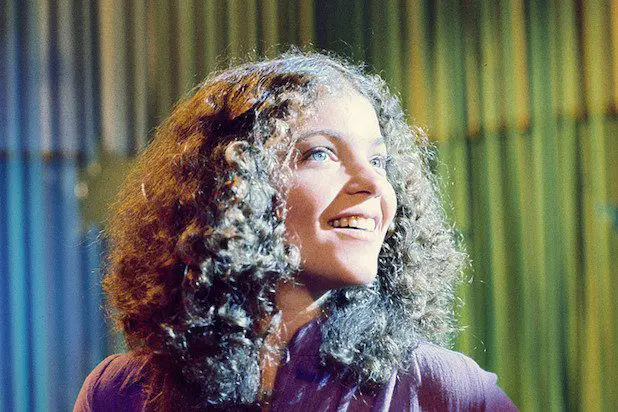
There’s this beautiful dance scene with Carrie and Tommy. A soft, sweet song plays in the background. The lyrics seem to speak to what is happening between them. The camera circles in one direction as the actors move in the other direction. This effect mirrors the dizzying emotions the characters must be feeling. I love how the film is ambiguous towards their feelings. We somewhat get the sense that real attraction might be forming between them, but we’re not completely sure. The scene in which the school declares Carrie their prom queen is also beautiful. We see it in slow motion as Carrie and Tommy move towards the stage. There’s this brief sliver of time where people seem genuinely happy for her. We’re genuinely happy for her. We start to feel there may be hope. That is, until what happens next.
I think here I should take a brief moment to discuss musical composer Pino Donaggio (Don’t Look Now, Tourist Trap). Donaggio might be the unsung hero of Brian DePalma’s thrillers. People don’t seem to discuss his work as much as other film composers, and yet he’s one of my favorites. Donaggio worked with other notable directors as well. He worked with Joe Dante (Gremlins, Matinee) on Piranha (1978) and The Howling (1981). He worked with Dario Argento (Suspiria, Phenomena) on Two Evil Eyes (1990), Trauma (1993), and Do You Like Hitchcock? (2005). Perhaps the most baffling credit on Donaggio’s resume would be for Seed of Chucky (2004). Yet I own that soundtrack as well.
Pino Donaggio’s best collaboration, however, was with Brian DePalma. To date, he has composed the music for seven of DePalma’s films: Carrie, Dressed to Kill (1980), Blow Out (1981), Body Double (1984), Raising Cain (1992), Passion (2012), and most recently, Domino (2019). I think his score for Carrie is his very best work. It’s not only one of my favorite horror movie scores. It’s one of my favorite musical scores period. He sells both emotion and tension. Though he himself prefers the softer ballads over the suspense themes.
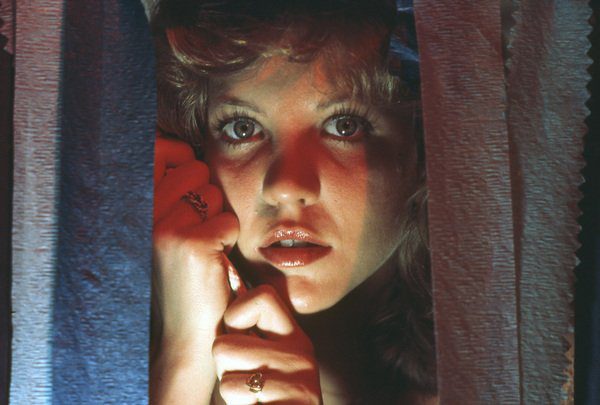
Carrie wouldn’t work nearly as well without Donaggio’s contribution. There are only two times in the film where his music doesn’t hold up. One is the detention scene, and the other is when the guys are getting their tuxes. The music is meant to imitate the comedic aspect of these scenes. They’re a bit too hokey and out-of-date by today’s standards though.
You might notice a couple of times where Donaggio uses violin musical stingers similar to the ones in Psycho. This is partly an homage to that film’s legendary composer Bernard Hermann. Hermann (Vertigo, Taxi Driver) had scored the music for DePalma’s films Sisters (1972) and Obsession (1976). He was going to score Carrie as well but passed away that same year. You might also notice how the high school in the film is Bates High School. That’s of course another reference to Psycho. Bates as in Norman Bates. Getting back to Pino Donaggio, his music is equally operatic with how DePalma uses the camera, if not more so. The best piece of music in the film is probably “Bucket of Blood”. The tension that theme creates is simply astounding.
The pig’s blood will fall, and Carrie will have her revenge. Better than the upcoming massacre, however, is the anticipation itself. There is a section in Carrie that I consider perfect. I wouldn’t change a single part about it. It might actually start as Tommy and Carrie arrive at prom. Though it’s definitely in effect by the time we get this one-shot which is just over two minutes long.
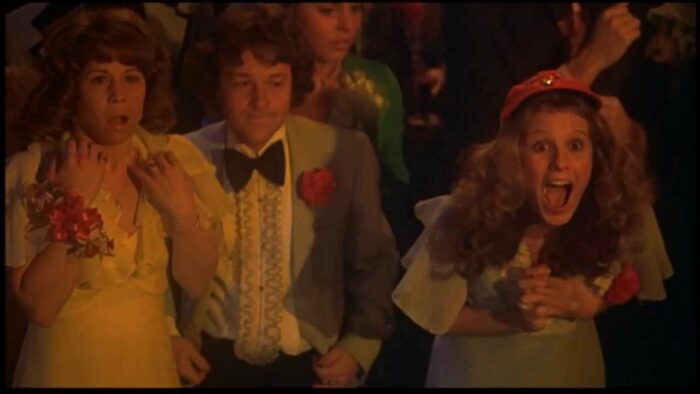
In this shot, we see everyone take their positions. Carrie and Tommy vote for themselves and hand their ballot to Norma and Freddy (Michael Talbott). Norma and Freddy are both working for Chris and Billy. They collect the votes, discarding some of them. They give the rest to the faculty counting them, including Miss Collins. Norma and Freddy pass by Chris and Billy, who are under the stage holding the rope. We follow the rope along the stage to see Sue Snell arriving backstage to peek in and see how Carrie’s night is going. Her hands graze the rope as the camera follows it up to the rafters. The rope leads to a bucket of pig’s blood, directly above the stage where they’ll crown the king and queen. As they announce the winners, the camera moves to Carrie and Tommy, now in the distance.
I’ve already mentioned the slow-motion scene as Carrie and Tommy make their way on stage. It’s a moment of beauty. That beauty transforms into a moment of chaos. All of our primary characters essentially do the wrong thing. Sue notices the rope. One end goes to a bucket above the stage. A pair of hands hold the other end under the stage. So Sue moves towards the stage. Miss Collins notices her and mistakes her intentions. We understand her suspicions. Yet we’re internally screaming for her to just listen to Sue. She, of course, doesn’t and kicks Sue out. This allows Chris the opportunity, not before seductively licking her lips, to yank the rope hard. She has an almost orgasmic reaction as she does so. The blood falls and hits its target.
There’s an awkward moment of silence as the students and faculty regard Carrie drenched in blood with shock. At first, the only noise we hear is the rope tied to the bucket swinging back and forth. Then we hear the bucket as it hits Tommy in the head, knocking him out cold. Tommy will die before he comes back to consciousness. In the past, I felt that we didn’t get enough confirmation that he did actually die. I do wish we had something more to establish it. The book is what really confirmed it for me.
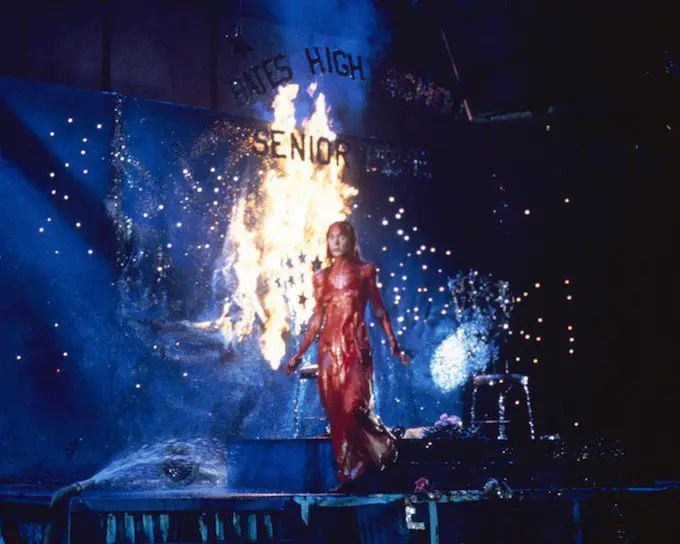
Then there’s what I’d call the “kaleidoscope” shots. I’ve always viewed these shots as conveying Carrie’s warped perspective. She pictures them all laughing at her, just like her mother said they would. Even Miss Collins is laughing, which has been under debate over the years. In the book, this character did indeed laugh. Though the way Betty Buckley plays her in the movie, I never once suspect that she’s actually laughing. Brian DePalma has confirmed that it’s all in Carrie’s imagination. I don’t think most of the people in these kaleidoscope images are actually laughing. The ones that do are most likely Chris Hargensen’s minions.
After these shots, Carrie goes into her telekinetic trance. Her eyes become wide. We see her in several rigid and awkward postures while in this trance. Most of all later when she causes Billy Nolan’s car to flip over, which kills both he and Chris. DePalma uses what would become his signature during the carnage: split-screen. He admits that he now regrets using so much of it for action. He feels it takes the viewer out of it.
A technique DePalma uses that I admire more is the split diopter lens. This allows the camera to focus on two separate people in different spaces equally in the same shot. You can see use of this earlier during the detention sequence or the English class that Tommy and Carrie share. Let’s get back to the massacre. Unlike the book, Miss Collins sadly dies in the movie. A basketball goal falls and crushes her. It took me the longest time to realize that’s what it was. It doesn’t look right. I love the shot where a teacher falls back into the mural as the whole thing goes up in flames. I think the massacre sequence suffers a bit though in comparison to the anticipation that came before it.
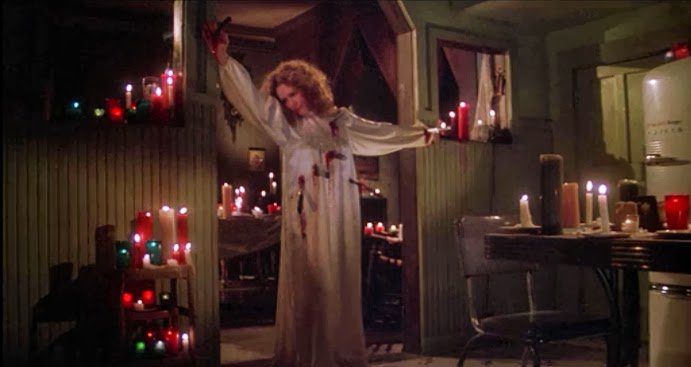
Carrie’s night isn’t over though. She goes home. A ridiculous amount of candles cover the home. It would be very easy for it to go up in flames. We see Margaret White waiting behind a bathroom door, though Carrie doesn’t see her. She gets a moment to herself. She takes a bath and breaks out of her trance, crying. We see her regress back to the meek, pathetic girl she was before. Yet she puts her clothes on as if she’s ready to put the night behind her and move on.
She has to contend with her mother though. As Margaret reveals herself to Carrie, the girl wants her mother to comfort her. Instead, she gets a knife in her back. The look of shock on Carrie’s face as her mother stabs her is heartbreaking. There is the briefest moment of regret on Margaret’s face. But then she gets this serene smile on her face. She practically floats towards Carrie, the knife still in her hand. She gets the best death in the movie. Chris Hargensen isn’t the only person to have an orgasmic reaction in the movie. Margaret White seems to moan almost in delight as she dies. In a sense, this is what she wants. To die means she can go to her creator. She most likely considers herself a dignified martyr.
Carrie dies too. The film, of course, ends with that memorable jump scare. It’s a dream sequence in which Sue Snell visits Carrie’s grave at her home. A “For Sale” sign is Carrie’s tombstone. Scrawled across it are the damning words, “Carrie White burns in hell.” As Sue lowers a bouquet of flowers, a hand comes out of the rubble, firmly grasping Sue’s arm. That arm did actually belong to Sissy Spacek. It’s a final scare that inspired countless others, perhaps most notably Friday the 13th (1980) and some of its sequels. Yet what I like more is what comes after. As Sue slips into madness, perhaps forever, Pino Donaggio gives us this wonderful musical crescendo. As the film cuts to black, the music also abruptly cuts short.
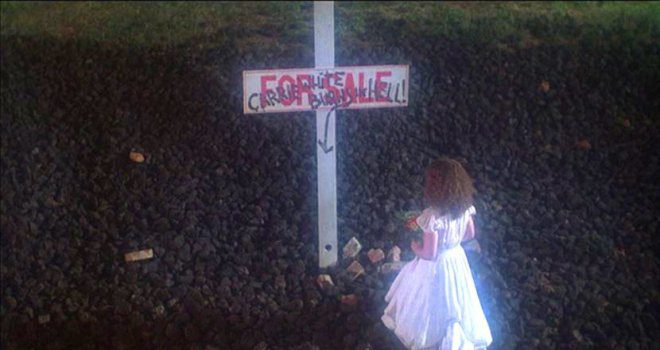
Brian DePalma consistently proves himself to be a strongly visual filmmaker. You see that across his career, these wonderfully operatic long sequences. Different film techniques, etc. What distinguishes Carrie among the rest however is its characterization. True, this characterization began in Stephen King’s original novel. He deserves perhaps more of the credit. But Brian DePalma and Sissy Spacek bring the character of Carrie White to life on screen. I struggle to think of a stronger character in all of DePalma’s films.
What amazes me is that she remains the character we most sympathize with throughout the entire movie. More than her so-called “victims.” More than the other characters who have a good heart and good intentions. She’s the one we’re most sad to see die. I am a fan of slasher movies. They are my horror movie “comfort food,” so to speak. But rooting for the killers in those movies is significantly different than the sympathy we feel for Carrie White. That is what makes Carrie special.
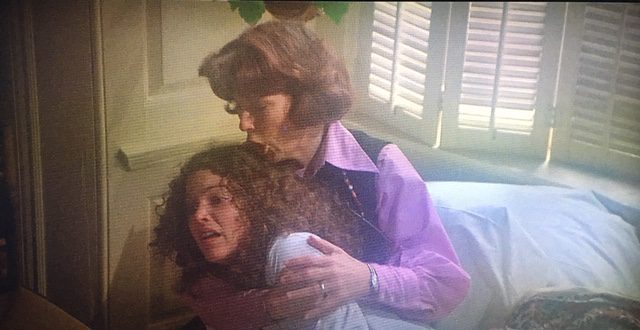




Thank you so much!
I saw Carrie last night on Netflix. Today, I found your article. Thank you. A very good read.
When I saw Carrie, and then when I read the book (13 years old), I knew that King knew what it felt like to be bullied in school. I felt like I had found a kindred soul.